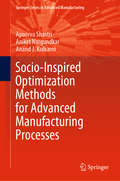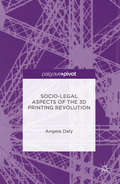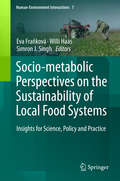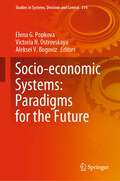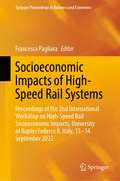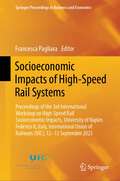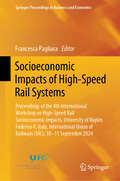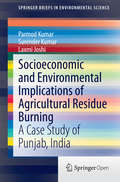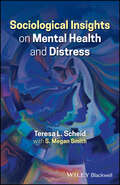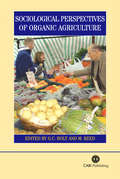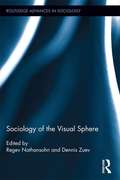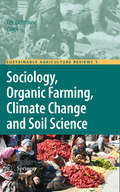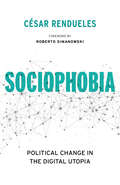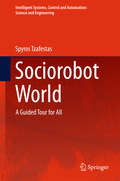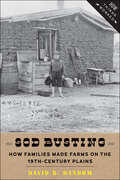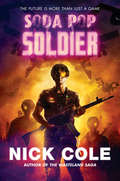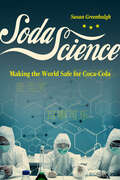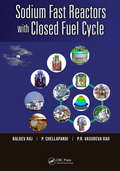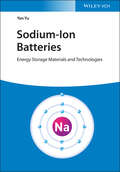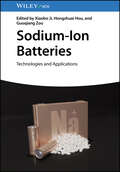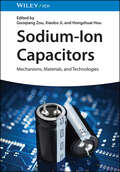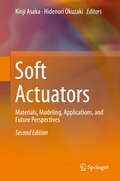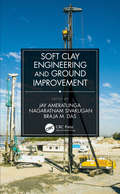- Table View
- List View
Socio-Inspired Optimization Methods for Advanced Manufacturing Processes (Springer Series in Advanced Manufacturing)
by Anand J. Kulkarni Apoorva Shastri Aniket NargundkarThis book discusses comprehensively the advanced manufacturing processes, including illustrative examples of the processes, mathematical modeling, and the need to optimize associated parameter problems. In addition, it describes in detail the cohort intelligence methodology and its variants along with illustrations, to help readers gain a better understanding of the framework. The theoretical and statistical rigor is validated by comparing the solutions with evolutionary algorithms, simulation annealing, response surface methodology, the firefly algorithm, and experimental work. Lastly, the book critically reviews several socio-inspired optimization methods.
Socio-Legal Aspects of the 3D Printing Revolution
by Angela DalyAdditive manufacturing or '3D printing' has emerged into the mainstream in the last few years, with much hype about its revolutionary potential as the latest 'disruptive technology' to destroy existing business models, empower individuals and evade any kind of government control. This book examines the trajectory of 3D printing in practice and how it interacts with various areas of law, including intellectual property, product liability, gun laws, data privacy and fundamental/constitutional rights. A particular comparison is made between 3D printing and the Internet as this has been, legally-speaking, another 'disruptive technology' and also one on which 3D printing is partially dependent. This book is the first expert analysis of 3D printing from a legal perspective and provides a critical assessment of the extent to which existing legal regimes can be successfully applied to, and enforced vis-à-vis, 3D printing.
Socio-Metabolic Perspectives on the Sustainability of Local Food Systems: Insights for Science, Policy and Practice (Human-Environment Interactions #7)
by Eva Fraňková Willi Haas Simron J. SinghThis book delves into diverse local food systems and critically assesses their ecological and societal benefits and trade-offs, their limits and opportunities for improving sustainability of food production, and framework conditions which either hinder or promote their development. More and more people with gradually meat heavier diets will demand growth in food production, whilst our increasingly industrialized and globalized agri-food system has already caused serious sustainability problems in the past. This calls for a change in the way we produce, distribute and consume food. A re-emerging debate on food security and food sovereignty seems to support this quest. But what are the promising alternatives to mainstream developments? Such a discussion regarding sustainability of local food systems requires a sound systemic understanding and thus invites a socio-metabolic reading of local cases by analyzing the nexus between material and energy flows as well as land and time use. This approach is needed to complement the so far mostly qualitatively-based local food studies. Applying socio-metabolic approaches to local food systems fosters a better understanding of promises and pitfalls for sustainable pathways in the future.
Socio-economic Systems: Paradigms for the Future (Studies in Systems, Decision and Control #314)
by Elena G. Popkova Victoria N. Ostrovskaya Aleksei V. BogovizThis book is reflective of a science-based vision of the future development paradigm of economic and social systems. It deals with the digitization as the technological basis for the future development of economic and social systems and presents a review of groundbreaking technologies and prospects for their application. The specific character of the industry and prospects for the application of digital technologies in business are analyzed. A rationale is provided for future prospects for the sustainable development of economic and social systems in a digital economy. The authors determine the process of the formation and development of the information-oriented society, social and educational aspects of the digitization, as well as the institutional framework of the digital future of social and economic systems. The book combines the best works following the results of the 12th International Research-to-Practice Conference “Artificial Intelligence: Anthropogenic Nature vs. Social Origin” that was held by the Institute of Scientific Communications (ISC) in cooperation with the Siberian Federal University and the Krasnoyarsk Regional Fund of support of scientific and scientific–technical activities on 5–7 December 2019, in Krasnoyarsk, Russia, as well as following the results of the 3rd International Research-to-Practice Conference “Economic and Social Systems: Paradigms for the Future” that was held by the ISC in cooperation with the Pyatigorsk State University on 5–6 February 2020. The target audience of the book consists of representatives of the academic community concerned with the future prospects for the development of economic and social systems, as well as economic agents engaged in the digitization of business processes, and representatives of public agencies regulating the development of business systems for their progressivity, sustainability and competitiveness.
Socioeconomic Impacts of High-Speed Rail Systems: Proceedings of the 2nd International Workshop on High-Speed Rail Socioeconomic Impacts, University of Naples Federco II, Italy, 13–14 September 2022 (Springer Proceedings in Business and Economics)
by Francesca PagliaraThis book offers new insights into the wider socioeconomic impacts of high-speed rail (HSR). Over the past few decades, significant investments have been made in these systems around the world. The use of public funds for the construction of high-speed rail offers a range of benefits, such as time savings, increased comfort, and reduced traffic congestion, as well as broader economic benefits, including the advancement of less developed regions. These proceedings feature papers presented at the 2nd International Workshop on the Socioeconomic Impacts of High-Speed Rail. The focus is on HSR’s impacts on equity and integration, the land use system, productivity, the environment, the tourism industry, and cooperation and integration with other modes of transport. The book provides an overview of the current state of practice from both theoretical and empirical perspectives. Consequently, it will be of interest to scholars of transportation economics and related fields, as well as transportation industry professionals.
Socioeconomic Impacts of High-Speed Rail Systems: Proceedings of the 3rd International Workshop on High-Speed Rail Socioeconomic Impacts, University of Naples Federico II, Italy, International Union of Railways (UIC), 12–13 September 2023 (Springer Proceedings in Business and Economics)
by Francesca PagliaraThis book offers new insights into the wider socio-economic impacts of high-speed rail (HSR). Over the past few decades, significant investments have been made in these systems around the world. The use of public funds for the construction of high-speed rail offers a range of benefits, such as time savings, increased comfort, and reduced traffic congestion, as well as broader economic benefits, including the advancement of less developed regions. These proceedings feature papers presented at the 3rd International Workshop on the Socioeconomic Impacts of High-Speed Rail. The focus is on HSR impacts on the environment, on the land use system, on investment, on the tourism industry, on inclusion and on cooperation vs integration with other transport modes. The book provides an overview of the current state of practice from both theoretical and empirical perspectives. Consequently, it will be of interest to scholars of transportation economics and related fields, as well as transportation industry professionals.
Socioeconomic Impacts of High-Speed Rail Systems: Proceedings of the 4th International Workshop on High-Speed Rail Socioeconomic Impacts, University of Naples Federico II, Italy, International Union of Railways (UIC), 10-11 September 2024 (Springer Proceedings in Business and Economics)
by Francesca PagliaraThis book offers new insights into the wider socioeconomic impacts of high-speed rail (HSR). Over the past few decades, significant investments have been made in these systems around the world. The use of public funds for the construction of HSR offers a range of benefits, such as time savings, increased comfort, and reduced traffic congestion, as well as broader economic benefits, including the advancement of less developed regions. These proceedings feature papers presented at the 4th International Workshop on the Socio-economic Impacts of High-Speed Rail. The focus is on impacts on the land-use system, competition vs. integration with alternative transport modes, investment, and evaluation. The book provides an overview of the current state of practice from both theoretical and empirical perspectives. As such, it is of interest to academics in transport economics and related fields, as well as professionals in the transport industry.
Socioeconomic and Environmental Impacts of Biofuels
by Alexandros Gasparatos Per StrombergBiofuels are currently in the middle of a heated academic and public policy debate. Biofuel production has increased fivefold in the past decade and is expected to further double by 2020. Most of this expansion will happen in developing nations. This volume is the first of its kind, providing a comprehensive overview of the biofuel debate in developing countries. The chapters are written by a multidisciplinary team of experts, exposing the key drivers and impacts of biofuel production and use. The book covers impacts as diverse as air pollution, biodiversity loss, deforestation, energy security, food security, greenhouse gas emissions, land use change, rural development, water consumption, and other socioeconomic issues. Its wide focus accommodates examples from countries in Africa, America, and Asia. As such, this book will become an indispensable companion to academics, practitioners, and policy makers who wish to know more about biofuel issues in the developing world.
Socioeconomic and Environmental Implications of Agricultural Residue Burning
by Surender Kumar Parmod Kumar Laxmi JoshiThis book discusses the important issue of the socioeconomic and environmental impacts of agricultural residue burning, common in agricultural practices in many parts of the world. In particular, it focuses on the pollution caused by rice residue burning using primary survey data from Punjab, India. It discusses emerging solutions to agricultural waste burning that are cost-effective in terms of both money and time. The burning of agricultural residue causes severe pollution in land, water and air and contributes to increased ozone levels and climate change in the long term. However, appropriate assessments have not been undertaken so far to demonstrate the relevant impact of agriculture-based pollution, especially residue burning. This book addresses this gap in the literature. Punjab has been used as a case study as it is the chief granary of India, contributing to 27. 2 percent of the Indian national produce of rice and 43. 8 percent of wheat. It is presumed that the findings from this state will be useful not only for other agricultural areas in India, but across the world. This book, therefore, sensitizes policy makers, researchers and students about the impacts of air pollution caused by agricultural residue burning---a subject not much dealt in the literature---and provides a way forward.
Sociological Insights on Mental Health and Distress
by Teresa L. Scheid S. Megan SmithIntroduces students to the study of the social forces that shape mental health and empowers the next generation to make an impact on mental health management As the prevalence of mental health issues worldwide continues to grow, an active area of sociology is investigating the social causes and consequences of mental health and illness. Young people are especially vulnerable to the current mental health crisis—they are more frequently experiencing social isolation, family stressors, difficulties establishing social relationships, and heightened levels of anxiety, depression, loneliness, and suicidal thoughts. Using a relatable and accessible narrative style, Sociological Insights on Mental Health and Distress helps students understand the connections between mental health issues and their social and structural determinants. Integrating classical and contemporary sociological theory, this concise textbook examines mental health from four key sociological perspectives: social context, social integration, stress, and stigma. Special emphasis is placed on the role of social media and cyberbullying in mental health concerns, global sources of anxiety such as COVID-19 and climate change, and emerging topics including neuro-divergencies in mental health problems and suicide in LGBTQ+ and BIPOC communities. Supported by a wealth of pedagogical tools and an extensive companion website, Sociological Insights on Mental Health and Distress is the perfect textbook for undergraduate courses in the sociology of mental health, health and illness, psychological and sociological deviance, and social problems, as well as interdisciplinary courses in criminal justice, public health, social work, and psychology.
Sociological Perspectives of Organic Agriculture: From Pioneer to Policy
by Georgina Holt Matthew ReedThis book takes a fresh look at understanding the dynamics of the organic agricultural sector in Europe, Australia, South America and the US and depicts organic agriculture as an engine of growth for the organic sector and examines the important roles played by producers, and other parts of the supply chain such as consumers and certification standards. The authors demonstrate that the complexity of organic agriculture is closely connected to nature, society and economy.
Sociology of the Visual Sphere (Routledge Advances in Sociology #91)
by Dennis Zuev Regev NathansohnThis collection of original articles deals with two intertwined general questions: what is the visual sphere, and what are the means by which we can study it sociologically? These questions serve as the logic for dividing the book into two sections, the first ("Visualizing the Social, Sociologizing the Visual") focuses on the meanings of the visual sphere, and the second ("New Methodologies for Sociological Investigations of the Visual") explores various sociological research methods to getting a better understanding of the visual sphere. We approach the visual sphere sociologically because we regard it as one of the layers of the social world. It is where humans produce, use, and engage with the visual in their creation and interpretation of meanings. Under the two large inquiries into the "what" and the "how" of the sociology of the visual sphere, a subset of more focused questions is being posed: what social processes and hierarchies make up the visual sphere? How various domains of visual politics and visuality are being related (or being presented as such)? What are the relations between sites and sights in the visual research? What techniques help visual researcher to increase sensorial awareness of the research site? How do imaginaries of competing political agents interact in different global contexts and create unique, locally-specific visual spheres? What constitutes competing interpretations of visual signs? The dwelling on these questions brings here eleven scholars from eight countries to share their research experience from variety of contexts and sites, utilizing a range of sociological theories, from semiotics to post-structuralism.
Sociology, Organic Farming, Climate Change and Soil Science
by Eric LichtfouseSustainable agriculture is a rapidly growing field aiming at producing food and energy in a sustainable way for humans and their children. Sustainable agriculture is a discipline that addresses current issues such as climate change, increasing food and fuel prices, poor-nation starvation, rich-nation obesity, water pollution, soil erosion, fertility loss, pest control, and biodiversity depletion. Novel, environmentally-friendly solutions are proposed based on integrated knowledge from sciences as diverse as agronomy, soil science, molecular biology, chemistry, toxicology, ecology, economy, and social sciences. Indeed, sustainable agriculture decipher mechanisms of processes that occur from the molecular level to the farming system to the global level at time scales ranging from seconds to centuries. For that, scientists use the system approach that involves studying components and interactions of a whole system to address scientific, economic and social issues. In that respect, sustainable agriculture is not a classical, narrow science. Instead of solving problems using the classical painkiller approach that treats only negative impacts, sustainable agriculture treats problem sources. Because most actual society issues are now intertwined, global, and fast-developing, sustainable agriculture will bring solutions to build a safer world. This book series gathers review articles that analyze current agricultural issues and knowledge, then propose alternative solutions. It will therefore help all scientists, decision-makers, professors, farmers and politicians who wish to build a safe agriculture, energy and food system for future generations.
Sociophobia: Political Change in the Digital Utopia (Insurrections: Critical Studies in Religion, Politics, and Culture)
by César RenduelesThe great ideological cliché of our time, César Rendueles argues in Sociophobia, is the idea that communication technologies can support positive social dynamics and improve economic and political conditions. We would like to believe that the Internet has given us the tools to overcome modernity's practical dilemmas and bring us into closer relation, but recent events show how technology has in fact driven us farther apart.Named one of the ten best books of the year by Babelia El País, Sociophobia looks at the root causes of neoliberal utopia's modern collapse. It begins by questioning the cyber-fetishist dogma that lulls us into thinking our passive relationship with technology plays a positive role in resolving longstanding differences. Rendueles claims that the World Wide Web has produced a diminished rather than augmented social reality. In other words, it has lowered our expectations with respect to political interventions and personal relations. In an effort to correct this trend, Rendueles embarks on an ambitious reassessment of our antagonistic political traditions to prove that post-capitalism is not only a feasible, intimate, and friendly system to strive for but also essential for moving past consumerism and political malaise.
Sociorobot World
by Spyros TzafestasThis book makes a consolidated guided tour to the world of sociorobots (social or socialized robots). Sociorobots and assistive robots provide entertainment, assistance to the handicapped, companionship to the elderly and health care to autistic children and people with dementia. The book provides, in a fluent educational way, all major concepts, architectures and design methodologies. All types of sociorobots are examined, namely walking anthropomorphic, wheeled anthropomorphic, fixed-place anthropomorphic and zoomorphic sociorobots. The book provides an outline of sociorobot intelligent control architectures, robot learning and human robot interaction.
Sod Busting: How Families Made Farms on the 19th-Century Plains (How Things Worked)
by David B. Danbom“An excellent introduction to the challenges and opportunities of agricultural life in a difficult region for farming . . . elegantly written.” —Jeff Bremer, The Annals of IowaPrairie busting is central to the lore of westward expansion, but how was it actually accomplished with little more than animal and human power? In Sod Busting, David B. Danbom challenges students to think about the many practicalities of surviving on the Great Plains in the late nineteenth century by providing a detailed account of how settlers acquired land and made homes, farms, and communities. He examines the physical and climatic obstacles of the plains—perhaps America’s most inhospitable frontier—and shows how settlers sheltered themselves, gained access to fuel and water, and broke the land for agriculture.Treating the Great Plains as a post-industrial frontier, Danbom delves into the economic motivations of settlers, how they got the capital they needed to succeed, and how they used the labor of the entire family to survive until farms returned profits. He examines closely the business decisions that determined the success or failure of these farmers in a boom-and-bust economy; details the creation of churches, schools, and service centers that enriched the social and material lives of the settlers; and shows how the support of government, railroads, and other businesses contributed to the success of plains settlement.Based on contemporary accounts, settlers’ reminiscences, and the work of other historians, Sod Busting dives deeply into the practical realities of how things worked to make vivid one of the quintessentially American experiences, breaking new land.“A cogent and engaging portrait of the real lives of those who settled the Great Plains.” —Nebraska History
Sod Busting: How Families Made Farms on the Nineteenth-Century Plains (How Things Worked)
by David B. DanbomHow settlers transformed America’s most inhospitable frontier into an economic powerhousePrairie busting is central to the lore of westward expansion, but how was it actually accomplished with little more than animal and human power? In Sod Busting, David B. Danbom tells the story of Great Plains settlement in a way it has seldom been told before. Stretching beyond the sweeping accounts typical of standard textbooks, Danbom challenges students to think about the many practicalities of surviving on the Great Plains in the late nineteenth century by providing a detailed account of how settlers acquired land and made homes, farms, and communities. He examines the physical and climatic obstacles of the plains—perhaps America’s most inhospitable frontier—and shows how settlers sheltered themselves, gained access to fuel and water, and broke the land for agriculture. Treating the Great Plains as a post-industrial frontier, Danbom delves into the economic motivations of settlers, as well as the physically and economically difficult process of farm making. He explains how settlers got the capital they needed to succeed and how they used the labor of the entire family to survive until farms returned profits. He examines closely the business decisions that determined the success or failure of these farmers in a boom-and-bust economy; details the creation of churches, schools, and service centers that enriched the social and material lives of the settlers; and shows how the support of government, railroads, and other businesses contributed to the success of plains settlement.Based on contemporary accounts, settlers’ reminiscences, and the work of other historians, Sod Busting dives deeply into the practical realities of how things worked to make vivid one of the quintessentially American experiences, breaking new land.
Soda Pop Soldier
by Nick ColeWhen the virtual world gets real . . .Gamer PerfectQuestion fights for ColaCorp in WarWorld, an online combat-sport arena where megacorporations field entire armies in the battle for dominance over real-world global-advertising space. Within the immense virtual battlefield, players and bots are high-tech grunts, using dropships and state-of-the-art assault rifles to attack the enemy.But when times are tough, there's always the Black, an illegal open-source tournament where the sick and twisted desires of the future are given free reign. And what begins as PerfectQuestion's onetime effort to make some cash quickly turns dangerous.All too soon, the real and virtual worlds collide when PerfectQuestion refuses to become the tool of a madman intent on hacking the global economy for himself and fights to stay alive--in WarWorld, in the Black, and in the real world.
Soda Science: Making the World Safe for Coca-Cola
by Susan GreenhalghTakes readers deep inside the secret world of corporate science, where powerful companies and allied academic scientists mold research to meet industry needs. The 1990s were tough times for the soda industry. In the United States, obesity rates were exploding. Public health critics pointed to sugary soda as a main culprit and advocated for soda taxes that might decrease the consumption of sweetened beverages—and threaten the revenues of the giant soda companies. Soda Science tells the story of how industry leader Coca-Cola mobilized allies in academia to create a soda-defense science that would protect profits by advocating exercise, not dietary restraint, as the priority solution to obesity, a view few experts accept. Anthropologist and science studies specialist Susan Greenhalgh discovers a hidden world of science-making—with distinctive organizations, social networks, knowledge-making practices, and ethical claims—dedicated to creating industry-friendly science and keeping it under wraps. By tracing the birth, maturation, death, and afterlife of the science they made, Greenhalgh shows how corporate science has managed to gain such a hold over our lives. Spanning twenty years, her investigation takes her from the US, where the science was made, to China, a key market for sugary soda. In the US, soda science was a critical force in the making of today’s society of step-counting, fitness-tracking, weight-obsessed citizens. In China, this distorted science has left its mark not just on national obesity policies but on the apparatus for managing chronic disease generally. By following the scientists and their ambitious schemes to make the world safe for Coke, Greenhalgh offers an account that is more global—and yet more human—than the story that dominates public understanding today. Coke’s research isn’t fake science, Greenhalgh argues; it was real science, conducted by real and eminent scientists, but distorted by its aim. Her gripping book raises crucial questions about conflicts of interest in scientific research, the funding behind familiar messages about health, and the cunning ways giant corporations come to shape our diets, lifestyles, and health to their own needs.
Sodium Fast Reactors with Closed Fuel Cycle
by Baldev Raj P. Chellapandi P.R. Vasudeva RaoSodium Fast Reactors with Closed Fuel Cycle delivers a detailed discussion of an important technology that is being harnessed for commercial energy production in many parts of the world. Presenting the state of the art of sodium-cooled fast reactors with closed fuel cycles, this book:Offers in-depth coverage of reactor physics, materials, design, s
Sodium-Ion Batteries: Energy Storage Materials and Technologies
by Yan YuSodium-Ion Batteries An essential resource with coverage of up-to-date research on sodium-ion battery technology Lithium-ion batteries form the heart of many of the stored energy devices used by people all across the world. However, global lithium reserves are dwindling, and a new technology is needed to ensure a shortfall in supply does not result in disruptions to our ability to manufacture reliable, efficient batteries. In Sodium-Ion Batteries: Energy Storage Materials and Technologies, eminent researcher and materials scientist Yan Yu delivers a comprehensive overview of the state-of-the-art in sodium-ion batteries (SIBs), including their design principles, cathode and anode materials, electrolytes, and binders. The author discusses high-performance rechargeable sodium-ion battery technology in the contexts of energy, power density, and electrochemical stability for commercialization. Exploring a wide range of literature on the recent progress made by researchers on sodium-ion battery technology, the book provides valuable perspectives on designing better materials for SIBs to unlock their practical capabilities. A thorough introduction to sodium-ion batteries, including their key materials and likely future developments Comprehensive explorations of design principles of electrode materials and electrolytes for sodium-ion batteries Practical discussions of cathode materials for sodium-ion batteries, including transition metal oxides, polyanionic compounds, Prussian blue analogues and organic compounds In-depth examinations of anode materials for sodium-ion batteries, including carbon-based materials, metal chalcogenides, metal alloys, phosphorus and Na metal anodes Perfect for materials scientists, inorganic chemists, electrochemists, and physical chemists, Sodium-Ion Batteries: Energy Storage Materials and Technologies will also earn a place in the libraries of catalytic and polymer chemists.
Sodium-Ion Batteries: Technologies and Applications
by Xiaobo Ji; Hongshuai Hou; Guoqiang ZouSodium-Ion Batteries Practice-oriented guide systematically summarizing and condensing the development, directions, potential, and core issues of sodium-ion batteries Sodium-Ion Batteries begins with an introduction to sodium-ion batteries (SIBs), including their background, development, definition, mechanism, and classification/configuration, moving on to summarize cathode and anode materials, discuss electrolyte, separator, and other key technologies and devices, and review practical applications and conclusions/prospects of sodium-ion batteries. The text promotes the idea that SIBs can be a good complement, or even a strong competitor, to more mainstream energy technologies in specific application scenarios, including but not limited to large-scale grid energy storage, distributed energy storage, and low-speed electric vehicles, by virtue of considerable advantages in cost-effectiveness compared with lithium-ion, lead-acid, and vanadium redox flow batteries. This book delves into what we have done, where we are, and how we should proceed in regards to the advancement of SIBs, in order to make the technology more applicable in real-world situations. Specific sample topics covered in Sodium-Ion Batteries include: Electrochemical test techniques, including cyclic voltammetry, galvanostatic charge-discharge, and electrochemical impedance spectroscopy Advanced characterization techniques and theoretical calculation, covering imaging and microscopy, and the synchrotron radiation x-ray diffraction technique Designing and manufacturing SIBs, covering types of cells (cylindrical, soft-pack, and psitmatic), and design requirements for cells Performance tests and failure analysis, covering electrochemical and safety performances test, failure phenomenon, failure analysis method, and cost estimation Solid-state nuclear magnetic resonance spectroscopy, covering principles of ssNMR and shift ranges for battery materials A complete review of an exciting energy storage technology that is undergoing a crucial development stage, Sodium-Ion Batteries is an essential resource for materials scientists, inorganic and physical chemists, and all other academics, researchers, and professionals who wish to stay on the cutting edge of energy technology.
Sodium-Ion Capacitors: Mechanisms, Materials, and Technologies
by Guoqiang Zou; Xiaobo Ji; Hongshuai HouSodium-Ion Capacitors Enables readers to quickly understand core issues and field development of sodium-ion capacitors Sodium-Ion Capacitors summarizes and outlines the dynamics and development of sodium-ion capacitors, covering key aspects of the technology including background, classification and configuration, key technologies, and more, allowing readers to gain an understanding of sodium-ion capacitors from the perspective of both industrial technology and electrochemistry. Sodium-Ion Capacitors includes information on: EDLC-type mechanism of SCs and battery-type mechanism of SIBs, definition and types of pseudocapacitance, and energy storage mechanism of pseudocapacitors Cathode materials for sodium-ion capacitors, covering EDLC cathode materials, carbon nanotubes, reduced graphene oxide, and hollow carbon microspheres Flexible battery-type anode and capacitive cathode SICs cell configurations, including flexible electrodes based on carbon nanofiber, graphene substrates, carbon cloth, MXenes, and metal foil Pre-sodiation technologies, covering operation with Li metal, usage of Li-based alternatives, and the sacrificial additives method Summarizing the development, directions, potential, and core issues of sodium-ion capacitors, Sodium-Ion Capacitors is an essential resource on the subject for materials scientists, solid-state chemists and electrochemists, and semiconductor physicists in both industry and academia.
Soft Actuators: Materials, Modeling, Applications, and Future Perspectives
by Kinji Asaka Hidenori OkuzakiThis book is the second edition of Soft Actuators, originally published in 2014, with 12 chapters added to the first edition. The subject of this new edition is current comprehensive research and development of soft actuators, covering interdisciplinary study of materials science, mechanics, electronics, robotics, and bioscience. The book includes contemporary research of actuators based on biomaterials for their potential in future artificial muscle technology. Readers will find detailed and useful information about materials, methods of synthesis, fabrication, and measurements to study soft actuators. Additionally, the topics of materials, modeling, and applications not only promote the further research and development of soft actuators, but bring benefits for utilization and industrialization. This volume makes generous use of color figures, diagrams, and photographs that provide easy-to-understand descriptions of the mechanisms, apparatus, and motions of soft actuators. Also, in this second edition the chapters on modeling, materials design, and device design have been given a wider scope and made easier to comprehend, which will be helpful in practical applications of soft actuators. Readers of this work can acquire the newest technology and information about basic science and practical applications of flexible, lightweight, and noiseless soft actuators, which differ from conventional mechanical engines and electric motors. This new edition of Soft Actuators will inspire readers with fresh ideas and encourage their research and development, thus opening up a new field of applications for the utilization and industrialization of soft actuators.
Soft Clay Engineering and Ground Improvement
by Braja M. Das Jay Ameratunga Nagaratnam SivakuganSoft Clay Engineering and Ground Improvement covers the design and implementation of ground improvement techniques as applicable to soft clays. This particular subject poses major geotechnical challenges in civil engineering. Not only civil engineers, but planners, architects, consultants and contractors are now aware what soft soils are and the risks associated with development of such areas. The book is designed as a reference and useful tool for those in the industry, both to consultants and contractors. It also benefits researchers and academics working on ground improvement of soft soils, and serves as an excellent overview for postgraduates. University lecturers are beginning to incorporate more ground improvement topics into their curricula, and this text would be ideal for short courses for practicing engineers. It includes several examples to assist a newcomer to carry out preliminary designs. The three authors, each with dozens of years of experience, have witnessed and participated in the rapid evolvement of ground improvement in soft soils. In addition, top-tier professionals who deal with soft clays and ground improvement on a daily basis have contributed, providing their expertise in dealing with real-world problems and practical solutions.
